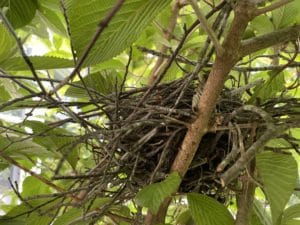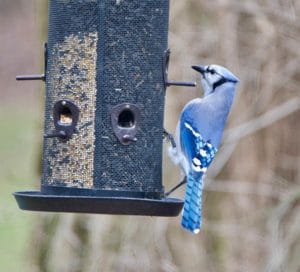Hello fellow readers, I have a confession to make about a grudge held for blue jays being aggressive, which originates from being beaked by one while jogging in Cliffside Park, NJ, where I once lived. They certainly are beautiful birds with sky blue coloring and black and white accents. And it turns out blue jays may not deserve their bad reputation, a lesson a recent blue jay came to teach.

Blue Jays fascinating behavior
So on with the research hat to learn both the male and female participate in nest building, though the boy primarily gathers and the girl mainly builds. And I found out they are complex social birds with a strong sense of family.
The blue jays were not around the next few days, maybe because of interrupting them by peering through the window. Then, three days later, one sat quietly nestled in a completed perfectly cupped home of twigs.
Each morning for a few weeks, the calm blue jay remained on the nest. One source said it’s only the female who incubates the eggs. Another writes the male steps in, but primarily, he gathers food for the female while she sits. They often mate for life.
There are typically 4 or 5 eggs, sometimes up to 7, that hatch in 16 to 18 days. Both the momma and poppa bring food to the baby birds. Then they’ll fledge the nest in 17 to 21 days and stick together, being fed by their parents for one to two months.
Blue jays are masterful copycats of other bird species—one of them, the loud warning call of a red-shouldered hawk, is to deceive other birds that a predator is present. To think, all these years, Curt’s frustration over the early morning screams waking us from a screened porch campout could have been blue jays.
Overcoming Blue Jays bad reputation
Cornell’s site (allaboutbirds.org) redeems the reputation for bullying their way into nests. “In an extensive study of blue jay feeding habits, only 1% of jays had evidence of eggs or birds in their stomachs.” Twenty-two percent of their diet is insects, and the remaining are fruits, grains, and nuts – acorns being their favorite, so if you’d like to attract these lovely birds plant an oak tree.
It’s fascinating to know they can carry five acorns at a time in their throat, upper esophagus, and beak. And, they stash an inventory in hidden spots—each jay can store as many as 3,000 to 5,000 nuts in one fall.
Much about their migration behavior is unexplained. For example, some blue jays migrate in large flocks, while others don’t migrate, and some migrate one year and not the next.
Maybe their bad reputation stems from their greedy way of taking over a feeder. Or from aerial attacks of other innocent joggers (smile).
But Blue Jays aren’t the biggest bully.
It turns out they aren’t the biggest bully at the birdfeeder. Instead, red-headed and red-bellied woodpeckers, common grackles, and squirrels dominate blue jays. And mourning doves, mockingbirds, and sometimes northern robins do too. It’s true; blue jays barge in with their red-shouldered hawk screech to trick the other birds into scattering, but they often quickly return.
I never saw the eggs as the sides of the nest rose high above them. Nor did I see or hear the youngsters if they hatched. But I grew attached to the little blue lady and looked forward to seeing her each morning.
Recall last week’s chat about a hawk pilfering frogs from the pond. Later that same morning, we heard a ruckus and saw a blue jay going after the hawk. It must have snagged the young from the nest; the momma and poppa never returned.
So there’s a lesson learned about the jay that beaked me long ago, undeserving of a grudge I held for so long. Blue jays aren’t necessarily aggressive and may not deserve their bad reputation; they protect and care for their families. Isn’t that true of all of us. Happy Father’s Day.
Garden Dilemmas? AskMaryStone@gmail.com (and your favorite Podcast App.)
More about birds (and more of Mike Niven’s photos) in Bird Fodder and Bird Fodder Part 2
Link to Cornell’s site about Blue Jays, including a nifty link to their fascinating sounds.



